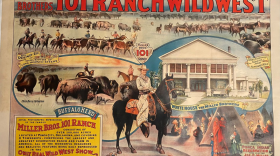The gopher is a small animal. It averages six to eight inches in length and weighs half a pound. They are sometimes called pocket gophers because they are small enough to fit in a pocket. But while they’re small, the agricultural damage they can do is astounding. In the early nineteenth century there were limited methods of controlling the little pest. So, it is not surprising that some localities in North Dakota offered a bounty on these burrowing rodents.
Pocket gophers have poor eyesight, but a keen sense of smell. They dig extensive tunnel systems. A single gopher can dig a system that covers an acre of ground. They are rarely seen because they spend most of their lives below ground. The mounds of earth they leave at tunnel entrances are a sure sign that gophers are present.
Much of the damage they do comes from eating the roots of plants. Root vegetables like carrots and potatoes are a welcome meal. They’ll even eat tree roots. And by killing trees, they decrease soil retention. When the gophers venture above ground, they pull the green tops off plants and bring them into their burrows to eat in safety.
The pests can even gnaw through underground plastic water pipes and electric cables. They also damage irrigation dikes. It is not uncommon to find six to ten gophers per acre in a field of sweet clover or alfalfa.
The gophers can actually do some good, increasing the fertility of the soil by loosening it, which allows air and water to pass through more easily.
On this date in 1912, the Bismarck Tribune announced that Burleigh County would pay a bounty of one cent per gopher. The bounty would be paid in May and June and would extend into July if there was enough money. Bounty hunters were required to bring in the tail and a strip from the back for payment. The statute was very clear that the bounty would only be paid on gophers killed within the county. However, it did not state just how the proof of residency would be determined.
Dakota Datebook written by Carole Butcher
Sources:
Bismarck Daily Tribune. “Gopher Bounty Will Be Paid by County.” Bismarck ND. 4/2/1912. Page 2.
North Dakota State University Cooperative Extension Service. “Control of Field Mice, Pocket Gophers, and Ground Squirrels.” https://library.ndsu.edu/ir/bitstream/handle/10365/16747/A-243-1972.PDF?sequence=1 Accessed 3/2/2020.



